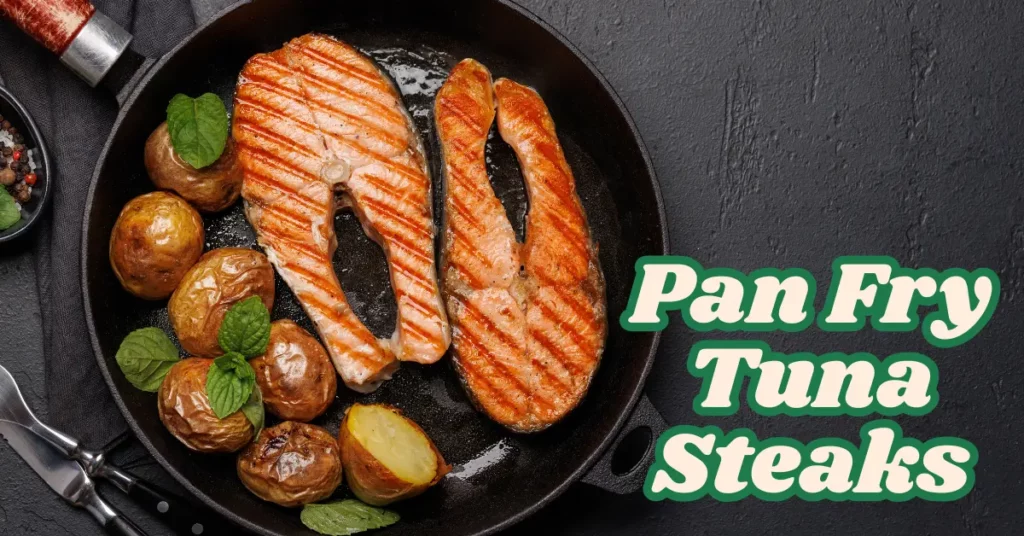This post may contain affiliate links. If you use these links to buy something we may earn a small commission. Thanks.
Tuna steaks are a true delicacy in the seafood world. With their meaty texture, bold flavor, and nutritional benefits, they’ve become a go-to protein source for home cooks and gourmet chefs alike. While there are several methods to prepare tuna steaks, pan frying remains one of the fastest, easiest, and tastiest ways to bring out their rich flavor.
But one question continues to puzzle many: how long should you pan fry tuna steaks? The answer depends on several key factors like thickness, doneness preference, and cooking equipment. In this comprehensive guide, we’ll walk you through everything you need to know to pan fry tuna steaks to perfection every single time.
Factors That Affect Pan Frying Time
1. Thickness of Tuna Steaks
The thickness of your tuna steak plays the most critical role in determining cook time. A thinner steak (½ inch or less) will cook much faster than a thick cut (1 inch or more). Always adjust your cooking time according to the steak’s size.
2. Desired Doneness
Everyone has a different preference when it comes to tuna:
- Some love a seared crust with a cool, red center.
- Others prefer it warm and pink throughout.
- A few even like it fully cooked.
Since tuna cooks quickly, even a minute or two can change the doneness dramatically.
3. Type of Tuna
Yellowfin (also known as Ahi), Bluefin, Albacore, and Bigeye are commonly sold in steak form. Bluefin and Yellowfin are more forgiving and ideal for rare to medium-rare cooking. Albacore, on the other hand, tends to dry out faster and is best with slightly shorter cooking times.
4. Heat Level
High heat is essential to get a nice sear while keeping the inside juicy and tender. Medium-high to high heat ensures a caramelized outer crust without overcooking the center.
5. Type of Pan
A cast iron skillet retains heat very well and produces a perfect crust, while non-stick pans are easier to manage but may not sear as deeply. Stainless steel is also a good option if you know how to prevent sticking.

Ideal Pan Frying Times Based on Doneness
Here’s a breakdown of approximate cook times per side depending on your doneness preference (assuming a 1-inch thick tuna steak and a properly preheated pan):
- Rare (Cool Red Center): 1 to 1½ minutes per side
- Medium-Rare (Warm Red to Pink Center): 2 to 2½ minutes per side
- Medium (Fully Pink Center, Slightly Opaque): 3 to 4 minutes per side
- Well-Done (Fully Opaque, No Pink): 5 minutes or more per side (generally not recommended due to dryness)
Keep in mind, tuna steaks continue to cook slightly after being removed from heat, so it’s smart to take them off just before your desired doneness.
How to Prepare Tuna Steaks for Pan Frying
1. Choose the Right Cut
Select fresh or high-quality frozen tuna steaks, ideally cut about 1-inch thick. Look for deep red, moist flesh without any discoloration or strong fishy odor.
2. Thaw Properly
If using frozen tuna, thaw it in the refrigerator overnight. For quicker results, place it in a sealed bag and submerge in cold water for 30-45 minutes.
3. Pat Dry for Better Sear
Excess moisture will steam the steak rather than sear it. Use paper towels to thoroughly dry the surface on both sides.
4. Season Generously
Tuna is naturally flavorful but benefits from light seasoning:
- Simple: Salt, pepper, garlic powder
- Gourmet: Cracked black pepper, sesame crust, chili flakes, lemon zest
- Marinades: Soy sauce, olive oil, lime juice, ginger, or teriyaki-style blends
Let the seasoning sit for 10-15 minutes before cooking for maximum flavor infusion.
Step-by-Step Guide: How to Pan Fry Tuna Steaks
Step 1: Preheat Your Pan
Place your skillet on medium-high or high heat and let it preheat for 2-3 minutes. Add 1-2 tablespoons of high-smoke-point oil (avocado, canola, or grapeseed oil work best).
Step 2: Place Tuna Steaks in the Pan
Lay the steaks in the hot pan carefully, pressing down slightly with a spatula to ensure full contact with the surface.
Step 3: Sear One Side
Cook undisturbed for your desired time (refer to cook time section). Don’t move the steaks around—let that crust form!
Step 4: Flip and Finish
Flip using tongs and sear the other side. You can add a pat of butter and aromatics like garlic or rosemary at this stage for flavor enhancement.
Step 5: Rest Before Serving
Remove from pan and let the tuna rest for about 3 minutes. This allows juices to redistribute and makes for a juicier bite.
Tips for Perfect Pan-Fried Tuna Steaks
- Don’t Overcrowd the Pan: Give each steak room to breathe. Cook in batches if needed.
- Use a Meat Thermometer (Optional):
- Rare: 110–115°F
- Medium-Rare: 125–130°F
- Medium: 135–140°F
- Crust It Up: Coat the steaks in crushed black pepper, sesame seeds, or herbs for added crunch and character.
- Sear Quickly: Tuna is best served with a crusty exterior and tender interior. Quick, high-heat cooking is key.
Serving Suggestions
Tuna steaks pair well with a wide range of sides and sauces. Here are some delicious ideas:
Sauces:
- Soy-Ginger Glaze
- Lemon-Garlic Butter
- Wasabi Aioli
- Cilantro-Lime Dressing
- Balsamic Reduction
Side Dishes:
- Garlic mashed potatoes
- Grilled asparagus or broccolini
- Coconut rice or jasmine rice
- Couscous or quinoa salad
- Mango salsa or pickled vegetables
Wine Pairing:
- A chilled Sauvignon Blanc, Rosé, or even light Pinot Noir pairs beautifully with pan-seared tuna steaks.
Common Mistakes to Avoid
- Overcooking Tuna: This is the most common error. Tuna dries out quickly — especially if you aim for well-done.
- Pan Not Hot Enough: This leads to steaming instead of searing.
- Skipping the Drying Step: Moisture on the surface prevents a proper crust.
- Too Much Oil: A greasy pan can lead to uneven cooking and oil splatter.
- Flipping Too Soon: Let the crust form before turning the steak.
Frequently Asked Questions (FAQs)
Can You Cook Tuna Steaks from Frozen?
It’s not ideal. Tuna cooks so quickly that starting from frozen often leads to uneven doneness. Always thaw completely for best results.
How Do You Know When Tuna Steaks Are Done?
Visual cues like color change and firmness help. Rare steaks feel soft with a seared crust; medium steaks are slightly firmer with a warm pink center. A meat thermometer can provide added assurance.
Is It Safe to Eat Tuna Rare or Medium-Rare?
Yes — as long as the tuna is sushi-grade or sourced from a reputable supplier. In fact, most restaurants serve tuna rare to medium-rare.
How Do I Prevent Tuna From Sticking to the Pan?
Use enough oil, preheat your pan properly, and don’t move the tuna until it naturally releases from the surface. A hot pan is your best friend here.
Conclusion
Pan frying tuna steaks is a quick and flavorful way to enjoy this nutritious fish. With just a few minutes on each side, you can achieve that perfect sear while keeping the inside succulent and satisfying. Whether you love your tuna barely kissed by the pan or cooked a bit more through, understanding the nuances of heat, time, and preparation is key.
Now that you know how long to pan fry tuna steaks, you’re well on your way to cooking restaurant-worthy seafood right in your kitchen. Just remember: a hot pan, good timing, and quality tuna are all you need to impress your palate and your guests.
